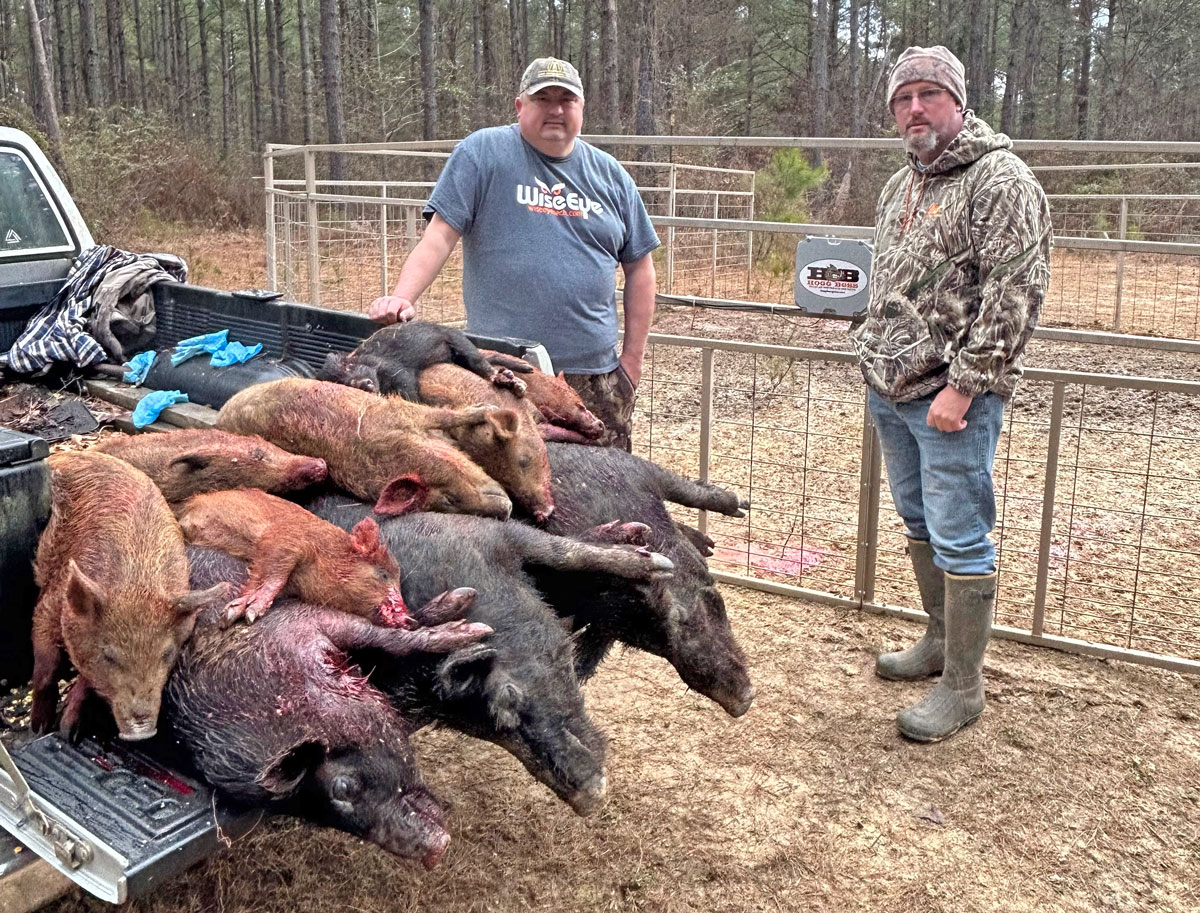
State falls short controlling feral pigs; hunters, trappers need help
Feral pigs remain a major problem in Louisiana. The swine, which ruin precious crops and ravage hunting grounds, have invaded all 64 parishes.
Jim LaCour, state wildlife veterinarian for Louisiana Department of Wildlife and Fisheries (LDWF), gave the dismal report at the monthly commissioners meeting on Feb. 2.
The state doesn’t even have a solid estimate on the numbers of feral hogs, but LaCour gave a wide-ranging estimate of between 600,000 to 1.2 million. With sows birthing two litters a year and each litter averaging six piglets, the numbers will continue to grow further out of control.
Some hunters and trappers have taken on the monumental task of deterring the tidal wave of pigs at their own expense without help from the LDWF.
“We are finding there are groups of hunters that have very good equipment,” LaCour said. “They have night shooting equipment and semi-automatic rifles. There are a number of these folks out there that are getting permission and working with farmers, and they are killing 1,000 pigs each each year. They are becoming very efficient at killing these pigs.”
Not a dent
However, eliminating 1,000 pigs a year doesn’t make a dent in a population of a million. In north Louisiana, Peyton McKinnie and a group of men started trapping swine two years ago using a cellular-controlled Hogg Boss system. Hogs are intelligent and quickly learn to be trap weary when only one or two hogs from a sounder or group are caught at a time. With the technology McKinnie uses and a cellular game camera, he controls how many hogs are caught and when the trap is activated.
“More and more people were coming to us saying they couldn’t hunt because of the hogs,” explained McKinnie, who traps in and around Marion. In two years, McKinnie has caught approximately 1,100 in Marion’s zip code. Additionally, he said people with hog dogs average about 100 hogs.
“What I have learned is those big boars with those big tusks don’t like to go inside the trap,” McKinnie said. “So, when we trap a sounder, I get Eric McPherson to go and try to get the boar (with the dogs).”
In Concordia Parish in central Louisiana, Jody Green and Jeff Goeggle said the hog population had declined some, but expected it to rise if hunting the swine declines.
“We were seeing groups of 30 or 40 hogs (in the beginning),” Green said. “It got down to 10 in the group and that was a big group. There were people that weren’t able to plant or had to plant two or three times.”
Goeggle seemed to think pig numbers were down some in Concordia, but, “The numbers are going to get worse.” Goeggle used to kill some 500 pigs annually.
Damaging economy
In Concordia, row crops provide much of the economic driving force. When feral pigs migrate to an area, they ravage the farmland, digging or rooting up much of the crop. According to a 2015 LSU AgCenter survey, estimated damage from hogs were $75 million annually in Louisiana for row crop agriculture.
“That is a very significant impact for our state,” LaCour said. And that estimate was based on costs and prices from seven years ago.
They affect all the other species in the woods, like deer and turkey, LaCour said. Feral pigs often eat much of the acorns and other food sources that deer eat. According to McKinnie, since hogs have moved in, he went from seeing 15 to 20 deer to seeing five all year. McKinnie, an avid deer hunter, is also owner of Tiger Bend Outdoors.
LDWF officials have looked into the use of toxins, but that could take years for final development and approvals.
During the meeting, LaCour was asked about LDWF officials putting a bounty on feral pigs similar to nutria. LaCour answered there was no domestic counterpart to nutria. Georgia tried a $40 pig bounty program, but some people started abusing the program by going to butcher shops and getting pig tails. Hunters would receive $40 a pig tail in the Georgia program.
Creative ideas needed
McKinnie said that could be solved by requiring hunters to provide the feral pig tail along with a before and after photo of the hog. McKinnie also offers several other suggestions LDWF could do to curb the feral pig population, instead of talk about it.
LDWF could be more lenient on WMAs for hog dogs, and work with companies that own land to get permits to trap hogs and advertise the hunting of feral pigs as more of a sport. Also, he suggested the state give grants for corn and feed for hog trappers or tax breaks with the state for expensive equipment to trap hogs. McKinnie gives the pig meat to needy families.
LDWF could also have a hog derby or contest sponsored by the state, McKinnie suggested. Or hog trappers could partner with LDWF to put on seminars on how to effectively trap hogs. Whatever LDWF officials decide to do, everyone agrees something must be done soon.
Otherwise, the lack of management will allow the nuisance to continue running hog wild over the state’s wildlife, outdoor and agricultural resources.
